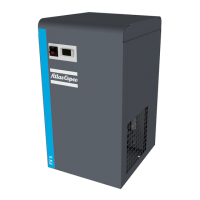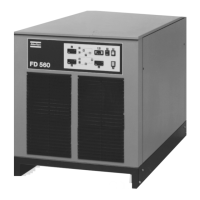2920 1443 01
5
Instruction book
1.2 Air drying circuit (Fig. 1.4)
Wet air from the compressor aftercooler (2) enters the dryer
inlet, passes through inlet valve (5) and the nozzle of ejector
(11) into air inlet water separator (26). The air leaving the
aftercooler is normally saturated and has a temperature of approx.
10°C above that of the inlet cooling water on water-cooled
compressors or above that of the ambient temperature on air-
cooled compressors.
In the demister (27), the water droplets are removed from the
air. The air is then led through rotor (12), which adsorbs the
water vapour. The dried air then flows into air outlet
compartment (30) and leaves the dryer through outlet valve (33).
1.2.1 Regeneration air circuit
Hot regeneration air is branched off from pipe (1) upstream of
the compressor aftercooler. This air is unsaturated and has a
temperature of 130-190°C, depending on the operating pressure,
the cooling water inlet temperature or ambient temperature and
the air inlet temperature.
The regeneration air passes through shut-off valve (7), throttle
valve (8) and strainer (9) to inlet sealing sector (10), and is
blown through the wet rotor channels. Since the hot air has a
lower vapour pressure than the wet rotor channels, it will dry,
i.e. regenerate, the rotor.
The wet regeneration air leaving the rotor is collected in outlet
sealing sector (14).
The hot saturated air is then cooled down in regeneration air
cooler (17) and passed to water separator (18), where the free
water is evacuated by the drain system.
The regeneration air is then led to the suction chamber (28) of
ejector (11), where it is mixed with the wet compressed air from
the compressor aftercooler. In the ejector the velocity of the
wet compressed air is increased, resulting in a pressure drop in
the suction chamber of the ejector and the entire regeneration
air circuit up to throttle valve (8). The pressure drop prevents
regeneration air from entering the dry air outlet compartment.
1.2.2 Rotor cooling air circuit
After regeneration, the hot channels of the rotor are cooled by
air from the dry air compartment (30). The cooling air flow is
trapped by the regeneration air outlet sealing sector (14) and
mixed with the wet regeneration air.
1.3 Drain system
1.3.1 Description (Fig. 1.5)
The condensate enters the Electronic Water Drain (EWD) via
inlet (1) and accumulates in collector (2). A capacitive sensor
(3) continuously measures the liquid level. As soon as the
collector is filled up to a certain level, pilot valve (4) is activated
and diaphragm (5) opens outlet (6), discharging the condensate.
When the collector has been emptied, the outlet closes quickly
without wasting compressed air.
When the controller registers a malfunction, the red alarm LED
(Fig. 1.7) starts flashing and the electronic drain valve will
automatically change to the alarm mode, opening and closing
the valve according to a sequence as shown in (Fig. 1.6). This
condition continues until the fault is remedied. If the fault is not
remedied automatically, maintenance is required.
1.3.2 Testing the EWD
Functional test
Briefly press the TEST button (Fig. 1.7) and check that the valve
opens for condensate discharge.
Checking the alarm signal
- Press the test button for at least 1 minute
- Check that the alarm LED flashes
- If an alarm device is connected to the NO or NC contact
(see section 1.3.3), check its operation.
- Release the test button.
1.3.3 Electrical connections of the EWD (Fig. 1.8)
The indications on the data label must correspond to the mains
supply voltage and frequency. Connect the electrical supply to
the EWD as shown in Fig. 1.8. Never operate the EWD without
an earth conductor connected. An alarm device can be connected
to the normally open or normally closed contact; see Fig 1.8.

